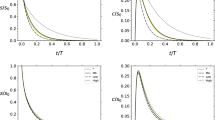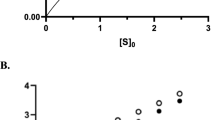Abstract
Equations are presented which describe a linear coupled system of reactions that utilize a single substrate and convert it to product by way of several intermediate enzyme catalysed steps. The present analysis extends previous results by assuming that the enzymes obey reversible Michaelis-Menten kinetics. In order for the system to reach steady state one must assume that the initial substrate concentration and the final product concentration are buffered to a constant value. Using the present analysis it can be shown that the system will not enter a steady state if the maximal velocity of any forward reaction is less than the steady state flux through the system. This condition represents a practical test for determining if a system will enter steady state but is valid only when the rate of the primary enzyme is not affected allosterically be intermediates in the pathway. The equations are used to analyse a portion of the rat liver glycogenic pathway that catalyses the conversion of glucose to fructose 1,6-bisphosphate.
Similar content being viewed by others
References
Easterby JS: Coupled enzyme assays: A general expression for the transient. Biochim Biophys Acta 293: 552–558, 1973
Easterby JS: A generalized theory of the transition time for sequential enzyme reactions. Biochem J 199: 155–161, 1981
Brooks SPJ, Espinola T, Suelter CH: Theory and practical application of coupled enzyme reactions: One and two auxiliary enzymes. Can J Biochem Cell Biol 62: 945–955, 1984
Brooks SPJ, Espinola T, Suelter CH: Theory and practical application of coupled enzyme systems: One and two coupling enzymes with mutarotation of an intermediate. Can J Biochem Cell Biol 62: 956–963, 1984
Brooks SPJ, Suelter CH: Practical aspects of coupling enzyme theory. Anal Biochem 176: 1–14, 1989
Kascer H, Burns JA: Molecular Democracy: Who Shares the controls? Biochem Soc Trans 7: 1151–1160, 1979
Cornish-Bowden A: Fundamentals of Enzyme Kinetics. Butterworth & Co., London, 1979, pp 31
Torres NV, Mateo F, Melendez-Hevia E, Kacser H: Kinetics of metabolic pathways. A system in vitro to study the control of flux. Biochem J 234: 169–174, 1986
Torres NV, Souto R, Melendez-Hevia E: Study of the flux and transition time control ceofficient profiles in a metabolic system in vitro and the effect of an external stimulator. Biochem J 260: 763–769, 1989
Torres NV, Mateo F, Riol-Cimas JM, Melendez-Hevia E: Control of glycolysis in rat liver by glucokinase and phosphofructokinase: Influence of glucose concentration. Mol Cell Biochem 93: 21–26, 1990
Kascer H, Burns JA: The control of flux. Symp Soc Exp Biol 27: 65–104, 1973
Porteous JW: Control analysis: A theory that works. In: A Cornish-Bowden, ML Cardenas (eds.) Control of Metabolic Processes. Plenum Press, New York, 1990, pp 51–67
Heinrich R, Rapoport TA: A linear steady-state treatment of enzymatic chains: General properties, control and effector-strength. Eur J Biochem 42: 89–95, 1974
Groen AK, Westerhoff HV: Modern control theories: A consumers' test. In: A Cornish-Bowden, ML Cardenas (eds.) Control of Metabolic Processes. Plenum Press, New York, 1990, pp 101–118
Press WH, Flannery BP, Teukolsky SA, Vetterling WT: Numerical recipes in C. The art of scientific computing. Cambridge University Press, Cambridge, 1986, pp 547–563
Scrutton MC, Utter MF: The regulation of glycolysis and gluconeogenesis in animals tissues. Ann Rev Biochem 37: 249–302, 1986
Hers HG, Hue L: Regulation of glucolysis in animal tissue. Ann Rev Biochem 52: 617–653, 1983
Barman TE: Enzyme Handbook, Springer-Verlag, New York, 1969
Dunaway GA: A review of animal phosphofructokinase isozymes with an emphasis on their physiological role. Mol Cell Biochem 52: 75–91, 1983
Author information
Authors and Affiliations
Rights and permissions
About this article
Cite this article
Brooks, S.P.J., Storey, K.B. A kinetic description of sequential, reversible, Michaelis-Menten reactions: practical application of theory to metabolic pathways. Mol Cell Biochem 115, 43–48 (1992). https://doi.org/10.1007/BF00229094
Received:
Accepted:
Issue Date:
DOI: https://doi.org/10.1007/BF00229094




